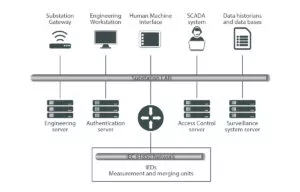Virtualization in digital substations
Increasing computing requirements in substations
In modern substations, an increasing number of field devices and automation components and a higher degree of automation means that more and more computers are required. Communication components and operator terminals (HMIs) as well as SCADA systems require hardware that meets stringent requirements to ensure safe operation of the substation environment. In many substations, there are separate computers for each individual function, such as small embedded computers but also 19“ station computers.
Through virtualization, many systems can be accommodated on one platform. Also, the construction of redundant systems becomes easier. Virtualization originally comes from the area of large IT data centers and abstracts IT resources by inserting an additional layer between application and hardware. This makes it possible to emulate and virtually provide services, operating systems on a common hardware. For the user, the virtual object behaves like a dedicated hardware or software object.
Development timeline of transformer station equipment
In substations, there are typically the following applications that have a specific need for computing power and
different requirements for operating systems or hardware resources:
- Intelligent operator terminals (HMIs)
- Authentication server with Lightweight Directory Access Protocol (LDAP) and RADIUS protocol
- Workstations for maintenance technicians or operating personnel
- Historical data databases for analysis and monitoring
- Communication gateways and data concentrators
- SCADA systems for monitoring and control
- Other automation equipment, PQ management etc.
Virtualization in digital substations
These applications are operated on individual computers in many substations. However, this entails high maintenance costs and is also not recommended for reasons of system redundancy. Each application uses hardware tailored to its needs, which however represents a single point of failure. In order to expand each application redundantly, a huge number of small computers must be installed, all of which would have to be kept in stock and maintained for possible replacement.
More topics
- Benefits of using virtualized computing power
- Virtualization – A cost driver?
- Investment protection through virtual machines
- Virtualizations in Transformer Stations – Design Considerations – Hardware requirements
- Hypervisor – But which one?
- Storage and resource management
- Redundancy architecture
- VLAN architecture and cost reduction through virtual Switches
- IT/OT Convergence
- Security challenges and requirements
Want to read more? Download below.

